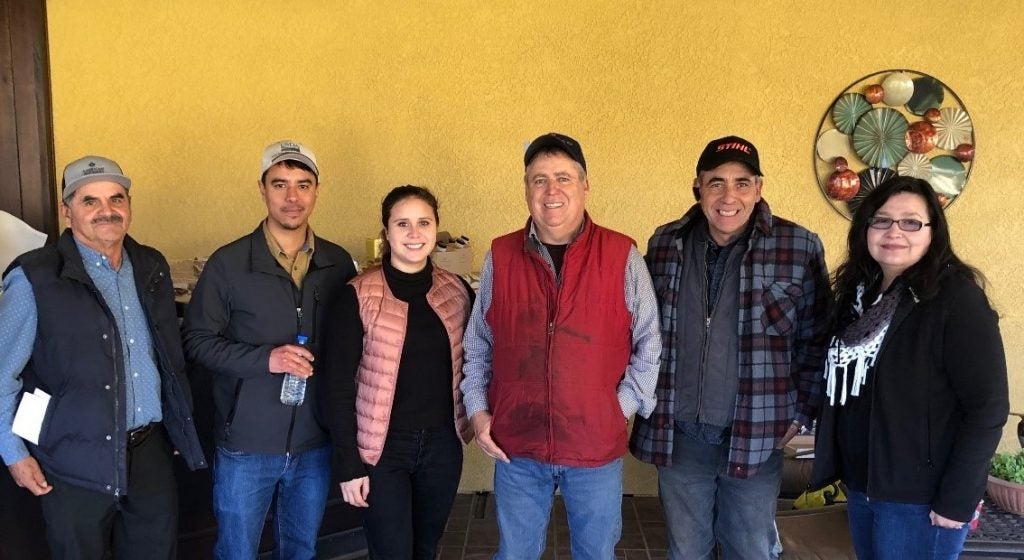Vicky Espinoza is on a mission. Vicky is passionate about making sure rural, low-income communities and small-scale farmers have a say in land-use and water-management decisions in the San Joaquin Valley.
During the last drought, California passed the Sustainable Groundwater Management Act (SGMA) because decades of groundwater overpumping was causing drinking wells to dry up, land to sink, and millions of dollars of damage to canals and other infrastructure. This new state mandate to sustainably manage groundwater and a warming climate will drive widespread changes in both land and water use in the valley, which in turn could affect agricultural jobs and regional economies.
Vicky, a Ph.D. candidate at UC Merced, wants to ensure that rural low-income communities — predominantly Latino and Hmong residents — are directly involved in decisions about these land-use changes, which is why she’s incorporating their opinions for the first time into a geospatial model to help guide the valley’s future and minimize negative impacts.
My colleagues and I have had the fortune of collaborating with Vicky on this important and timely project. I asked her to answer a few questions about her insights and the inspiration behind her work.

UC Merced candidate Vicky Espinoza (center) at her first independent farmer workshop a year ago. She is holding workshops on Jan. 13 (English) and Jan. 14 (Spanish) with small-scale farmers and rural community members to inform them about water and land-use decisions in the San Joaquin Valley, and incorporate their perspectives in decision-making. She has also produced short educational videos in English and Spanish on a YouTube channel called CaliWaterAg.
Can you explain your research and geospatial model?
My research focuses on the Sustainable Groundwater Management Act and how its impact on land use could affect low-income communities and small-scale farmers. It’s been projected that more than 10% of agricultural land will go out of production in the San Joaquin Valley to address groundwater overdraft, but what hasn’t been addressed is where this land will be.
My model will help visualize what the landscapes of the San Joaquin Valley could look like as land is taken out of production to reduce groundwater use. Unlike other models that include just one or two land uses, I’ll consider five (carbon sequestration, community revitalization, renewable energy, habitat restoration and groundwater recharge) to see how these different landscapes can work together or conflict.
But the feature that makes this work stand out the most is that it’s a community-informed model. My model will incorporate the voices of people who are impacted by these life-changing decisions: underrepresented communities and small-scale farmers.
What is the ultimate goal of this project?
My hope is that this work helps to close a decades-long equity gap in knowledge and decision-making, and provides insights into the value of co-developing water-management and land-use strategies with community members and growers.
Part of my goal is to make informing, empowering and involving underrepresented communities and farmers in the decision-making process a norm.
What has surprised you most about California water management?
One of the most surprising things to me is the inaccessibility to essential information and resources for non-English speaking community members. I have also been surprised by the minimal inclusion of underrepresented, low-income communities and small-scale farmers early in the planning of groundwater sustainability plans under SGMA.
To the credit of state and local agencies, there seems to be a stepped-up effort to make resources and tools, like translation services, more assessible during groundwater agency meetings. But there is still a lot more work to be done. Rural communities have long been ignored in water and land-use decisions in the San Joaquin Valley. Vicky Espinoza aims to change that. Share on X
What sparked your interest in water and rural communities?
After earning my undergrad degree, I had a one-year job at Argonne National Lab analyzing how climate change is affecting hydropower generation in California. It was 2014, during the last drought, so this work brought up questions about how the drought is impacting water in California. That led to my interest in not only water but agriculture and our society.
My mom is Mexican and my dad is Guatemalan. Spanish was my first language. Coming from humble beginnings in a heavily Hispanic community in Los Angeles, I feel I owe a lot to those people who believed in my potential and gave me opportunities. That’s why I’ve always dedicated time to tutoring or science outreach with community members. This project is an extension of that commitment.
What advice do you have for state and local agencies to better engage local communities in land- and water-use decision-making?
Community members are the ones who have to live with these decisions, and they have insights about the key issues, what works and what doesn’t for their community. No community is the same. Taking the time to inform, empower and involve our communities could avoid unwanted outcomes.
So my advice is to enter a community with respect, humility, and an open mind and heart. Invest time in these people who have been left out of important conversations for a long time.
What advice do you have for rural residents concerned about water and land-use changes?
Residents can help spread the word about my YouTube video channel, CaliWaterAg, to their neighbors and friends to help get their voices heard. They can become informed and be a part of the conversation so that they, too, have a say in water and land-use decisions. All voices matter! ¡Si se puede y si lo vamos a lograr — juntos! We can do it and we will achieve it — together!
There are a few upcoming opportunities for residents to attend workshops, ask questions and voice concerns:
Sign up for the English workshop Jan. 13 here.
Sign up for the Spanish workshop Jan. 14 here.









